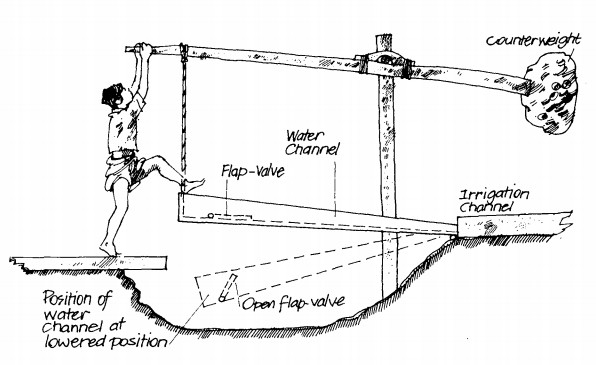Dhone

The dhone consists of a trough made from a wooden log or iron sheet; closed at one end and open at the other. The trough is mounted on a suspended pivoted lever to produce a see-sawing gutter or dhone which operates at relatively low lifts of up to 1.5 m.
The trough is lowered into the water by exerting pressure using a rope or the foot of the operator until the closed end is submerged in water. Upon releasing pressure the trough comes to its original position and the water is delivered to the irrigation channel. Typical yields of 80-160 l/min can be obtained from the dhone between 0.3-1.0 m. A straight canoe-shape can only lift water about half a metre whereas the curved type (banana shape) can lift to a height of 1.5m.
This device uses flap valves and can be operated by a single person shifting the weight back and forth at the fulcrum. 1
Suitable conditions
The dhone is used in Bangladesh.
It is also widely used (probably in the region of one million) along the Ganges and Brahmaputra rivers in the Indian sub-continent.
The dhone is a great improvement to the swing basket, as it only needs one person to operate, and can move more water, more quickly. It is a little more expensive than a swing basket, but considering it frees up a laborer and moves more water, it is still very cheap compared to other water lifting devices.
| Advantages | Disadvantages |
|---|---|
| - A relatively inexpensive traditional technology which can be locally made and maintained - Easy to operate |
- Limited to lifts of less than 1.5 m - Low to medium efficiency (20-50%) |
Construction, operations and maintenance
Instead of using a treetrunk, a dhone may be made of several planks of wood which can be assembled in the field with bolts. Galvanized iron sheets can also be used. Very large dhones should not be used as the discharge is reduced with increasing dhone volume (presumably because some of the input watts are wasted in manipulating the larger/heavier device (plus water) and so the time per cycle is disproportionately increased).
Note also that it has already been observed that with increased lifts, the overall efficiency of water lifting is considerably reduced. This is likely to be due to a greater spillage with increased lift, in addition to impaired ergonomics.
Costs
In Bangladesh, the higher initial costs of the dhone is the factor which inhibits its widespread adoption. There continues to be scope for some innovation in this method of lifting water.
Field experiences
A single dhone will lift 7.5 litre/sec at a lift of 0.75m (115gall/min at 30 inches), which reduces to about 2 litre/sec (30 gall/min) at 1.5m (or 60inches) head. Therefore the dhone will move more than twice as much water as a swingbasket at low lifts, moreover using the power of only one person rather than two. Many Bangladesh farmers try and use a single stage dhone at an overly high lift, and lose a lot of performance as a result; the optimum lift per stage is approximately 1m (40in). 2
Manuals, videos and links
References
- ↑ Food from Dryland Gardens - An Ecological, Nutritional, and Social Approach to Small-Scale Household Food Production (CPFE, 1991).
- ↑ Water Lifting Devices. FAO, 1986.
Acknowledgements
- Jane Olley, HUMAN & ANIMAL POWERED WATER-LIFTING DEVICES FOR IRRIGATION. Practical Action, November 2008.
- W. K. Kennedy and T. A. Rogers. Human and Animal-Powered Water Lifting Devices: A state of the art survey. Intermediate Technology Publications, 1985.

